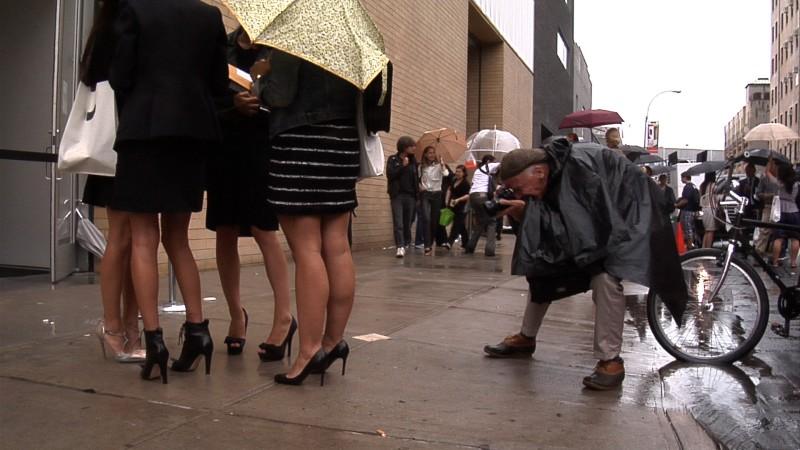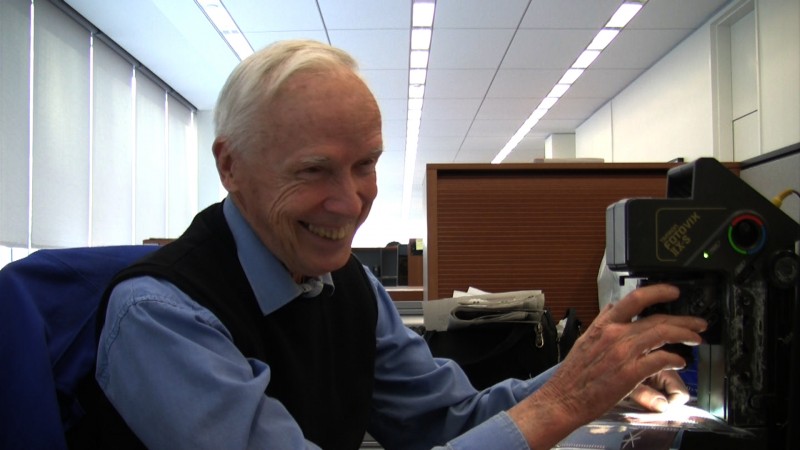Bill Cunningham New York | reviews, news & interviews
Bill Cunningham New York
Bill Cunningham New York
A captivating profile of one of New York's liveliest chroniclers

If you’re the kind of person who appreciates auto-recommendations based on previous purchases, then perhaps I could do worse than begin this review by saying:” If you liked The September Issue, you’ll simply love Bill Cunningham New York.” There are obvious similarities: both are Cinema Verité-style documentary profiles centred around New York and fashion, both present a series of talking heads, and both feature the formidable Anna Wintour, managing editor of American Vo
Bill Cunningham New York isn’t just a film for die-hard fashionistas. Indeed, fashion really isn’t its point (if it was, I’d have hated it). It’s a joyous and poignant profile of a character whose life has been completely driven by his twin obsessions: clothes and style – clothes, so it goes, being the armour that helps one face the world, style being that elusive thing that helps one carry it off. And though his tastes are certainly idiosyncratic – Anna Piaggi over Catherine Deneuve (who he refuses to photograph in a paparazzi scrum, uninterested in “cookie-cutter sameness”) – as a photographer now in his eighties, he still finds plenty to love not only amongst the well-heeled of New York’s charity ball circuit, but amongst - especially amongst - ordinary Manhattanites on the street. “On the Street” happens to be the title of his celebrated style column in the New York Times.
Cunningham’s images illustrate the apparent effortlessness in capturing each decisive moment
Cunningham himself, though extremely engaging, cuts an undistinguished figure. Though one contributor insists that “Bill is actually very stylish”, it’s an assessment you’d be hard-pressed to agree with. His “uniform” – he’s never seen in anything else – consists of crumpled slacks and those blue multi-pocket jackets worn by Parisian street-sweepers and purchased for around $20 in clear plastic off-the-peg packaging.
No doubt it’s the kind of look that helps him blend into the background as he goes about his business snapping stylish passers-by. He loves, he says, to work in the rain, since people are too busy battling the weather to notice you. And in a jaunty series of montages, Cunningham’s images illustrate the apparent effortlessness in capturing each decisive moment – though he insists his own decision-making processes are in abeyance. “I don’t decide anything,” he says. “I let the street speak to me, and in order for the street to speak to you you’ve got to stay out there and see what it is.” And though he acknowledges he is not among the true greats of either street or fashion photography (neither label seems a great fit, in any case) he’s certainly one of their liveliest chroniclers.
For Press, working closely with producer Philip Gefter and New York Times staff photographer Tony Cenicola, all of whom took turns in operating one of the hand-held cameras, gaining trust was a slow matter – filming would be put on hold if Cunningham wasn’t feeling particularly up to it. And clearly, the waiting game has been time well spent, since the film unearths more biographical information than Cunningham, a deeply private man with extremely monastic habits, has revealed to anyone in decades.
 It’s difficult to say why such a mystery has evolved around this genial, incredibly generous figure. One of his closest colleagues imagines how he must come from wealth, since only those cushioned by such a background could turn their back on material aspiration – a sentiment which expresses how incomprehensibly exotic they must find him, in a world in which the exotic feels so studied and contrived. Perhaps their ignorance says more about the self-obsessed fashion milieu than Cunningham’s admittedly rather stubborn and impressive reticence.
It’s difficult to say why such a mystery has evolved around this genial, incredibly generous figure. One of his closest colleagues imagines how he must come from wealth, since only those cushioned by such a background could turn their back on material aspiration – a sentiment which expresses how incomprehensibly exotic they must find him, in a world in which the exotic feels so studied and contrived. Perhaps their ignorance says more about the self-obsessed fashion milieu than Cunningham’s admittedly rather stubborn and impressive reticence.
Lovingly respectful of its subject, here the film treads carefully. Only towards the end do we get two personal questions: the first about Cunningham’s sexuality, the second about his religious faith. Cunningham’s responses are spare and punctuated by shyly evasive comments and long silences. This is difficult territory and the interviewer interjects twice with a gently reassuring “You don’t have to answer that.” In these quietly revealing moments, the film gets the tone just right.
Watch the trailer to Bill Cunningham New York
rating
Explore topics
Share this article
Subscribe to theartsdesk.com
Thank you for continuing to read our work on theartsdesk.com. For unlimited access to every article in its entirety, including our archive of more than 15,000 pieces, we're asking for £5 per month or £40 per year. We feel it's a very good deal, and hope you do too.
To take a subscription now simply click here.
And if you're looking for that extra gift for a friend or family member, why not treat them to a theartsdesk.com gift subscription?
more Film
 Anora review - life lesson for a kick-ass sex worker
Sean Baker's bracing Palme d'Or winner twists, turns, and makes a star of Mikey Madison
Anora review - life lesson for a kick-ass sex worker
Sean Baker's bracing Palme d'Or winner twists, turns, and makes a star of Mikey Madison
 Blitz review - racism persists as bombs batter London
Steve McQueen's overwought World War Two boy's adventure film delivers its message
Blitz review - racism persists as bombs batter London
Steve McQueen's overwought World War Two boy's adventure film delivers its message
 Small Things Like These review - less is more in stirring Irish drama
Cillian Murphy is exceptional as a man wrestling with his church and conscience
Small Things Like These review - less is more in stirring Irish drama
Cillian Murphy is exceptional as a man wrestling with his church and conscience
 The Room Next Door review - Almodóvar out of his comfort zone
The Spanish director's meditation on mortality is a beautiful misfire
The Room Next Door review - Almodóvar out of his comfort zone
The Spanish director's meditation on mortality is a beautiful misfire
 Blu-ray: The Outcasts
A forgotten Irish folk horror is eerily magical and earthed in the soil
Blu-ray: The Outcasts
A forgotten Irish folk horror is eerily magical and earthed in the soil
 London Film Festival 2024 - Nickel Boys, crime and punishment and Ukraine
Colson Whitehead's Pulitzer-winner adapted, a Belgian serial killer, Chinese odyssey and sexist Indian police in our final round-up
London Film Festival 2024 - Nickel Boys, crime and punishment and Ukraine
Colson Whitehead's Pulitzer-winner adapted, a Belgian serial killer, Chinese odyssey and sexist Indian police in our final round-up
 London Film Festival 2024 - a shaman and sham
Warren Ellis saves wildlife and himself, Pavement go post-modern in two music docs
London Film Festival 2024 - a shaman and sham
Warren Ellis saves wildlife and himself, Pavement go post-modern in two music docs
 Documentary highlights from the 2024 London Film Festival
A close look at insightful new non-fiction films about single motherhood, visionary photographers, scam artists, legacies of colonialism, and more
Documentary highlights from the 2024 London Film Festival
A close look at insightful new non-fiction films about single motherhood, visionary photographers, scam artists, legacies of colonialism, and more
 Venom: The Last Dance review - Tom Hardy's people-eater bows out
Poignancy studs the digital punch-ups as the super-alien saga concludes
Venom: The Last Dance review - Tom Hardy's people-eater bows out
Poignancy studs the digital punch-ups as the super-alien saga concludes
 theartsdesk Q&A: director Jacques Audiard on his Mexican trans gangster musical 'Emilia Pérez'
The French filmmaker concocted an extravagant genre mash-up to confront the tragedy of Mexico's 'disappeared'
theartsdesk Q&A: director Jacques Audiard on his Mexican trans gangster musical 'Emilia Pérez'
The French filmmaker concocted an extravagant genre mash-up to confront the tragedy of Mexico's 'disappeared'
 London Film Festival 2024 - Angelina Jolie does Maria Callas
Plus John & Yoko in New York, Elton in LA and Pauline Black in Coventry
London Film Festival 2024 - Angelina Jolie does Maria Callas
Plus John & Yoko in New York, Elton in LA and Pauline Black in Coventry
 Emilia Perez review - Audiard's beguiling musical tribute to Mexico's women
Exceptional female cast gives this 'comedy' a serious, angry core
Emilia Perez review - Audiard's beguiling musical tribute to Mexico's women
Exceptional female cast gives this 'comedy' a serious, angry core

Add comment